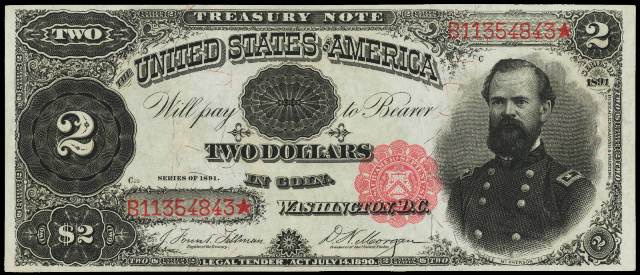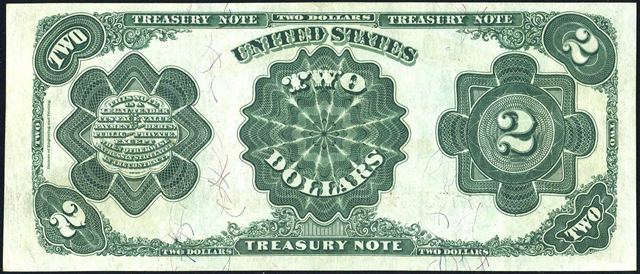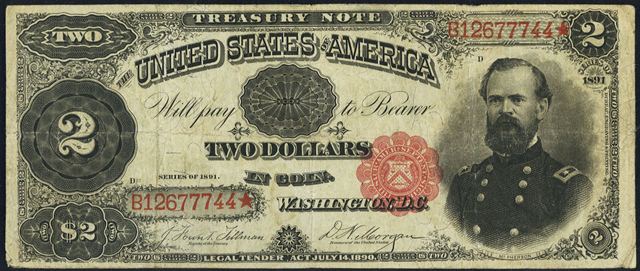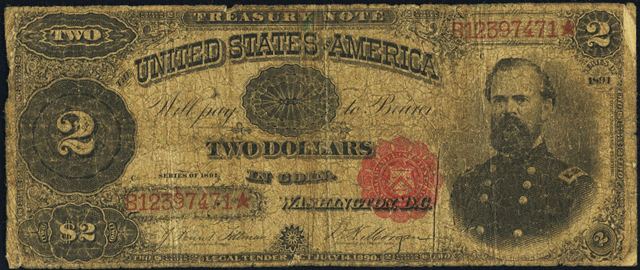Series of 1891 $2 Treasury Note– McPherson
History: Treasury notes were only printed in 1890 and 1891. We are specifically looking at the series of 1891 $2 treasury note. This note has a red seal and red serial numbers. It is larger than paper money is today. Our article has lots of great need to know information about this issue. If we can help you in anyway, please do not hesitate to contact us via email.
Nickname: There really isn’t an accepted nickname for 1891 $2 treasury notes. Collectors definitely refer to the portrait on the bill as a quick way to identify the item. McPherson was pictured on both the 1890 and 1891 treasury notes so you still have to get a little bit more specific. There is no overriding design element that stands out so for the seeable future we will be talking about 1891 McPhersons.
Other Facts: It is interesting to note that James B McPherson is the only person to die in the Civil War who was later featured on United States paper money. McPherson was also the second highest ranking Union officer to die in the Civil War. Collecting paper money by portrait has always been an interesting but very challenging way to put together a currency collection. It is also difficult to try to complete a collection of 1891 treasury notes. The $1,000 note is unique and a $500 1891 treasury note has yet to be discovered. Any denomination over $20 is very scarce and rarely seen.
Values and Grading: Most 1891 $2 treasury notes that we encounter are in the very good to fine range. We occasionally see very fines or something in the uncirculated grade if it is part of an advanced collection. There were no replacement star notes issued for this series. Yes, we know all notes end with a star symbol, but that is part of the design; it does not add a premium. There are only three signatures for 1891 $2 bills. Your exact note will either be signed by Rosecrans and Nebeker, Tillman and Morgan, or Bruce and Roberts. Each signature combination is equally common or rare, depending on how you look at it. We do see serial numbers under 100 from time to time. A number under 100 does add a small premium. However, 99% of the value is determined based on the condition (aka grade) of the note. Our guide below has pictures and grades for four different 1891 $2 bills. Contact us if you need more help with values.
Choice Uncirculated or Better: Truly uncirculated 1891 $2 treasury notes are few and far between. There are some runs of nice uncirculated notes, but lots of times there are very minor issues that keep high grade notes from grading 64 and higher. We see lots of slightly rounded corners and counting crinkles. An 1891 $2 bill in perfect condition will start at about $2,000 and go up from there based on paper quality and centering.

This 1891 $2 Treasury Note Is Beautiful But Rare In This Grade
Extremely Fine to About Uncirculated: It is rare that we see really nice looking but still lightly circulated 1891 $2 treasury notes. The 1891 $2 bill we have pictured below actually graded as a 40. The images we have don’t show any obvious folds. It is often difficult to accurately show condition just based on digital images. You really have to hold a note in hand and let light hit it at different angles to know what something actually grades. You can see why XF and AU grades are so popular. Sometimes there is absolutely no difference in the eye appeal between XF and Gem CU, so some collectors have no problem settling for something in the XF grade for a fraction of the price.

This Is What The Back Of An 1891 $2 Treasury Note Looks Like
Fine to Very Fine: Most collectors would like nothing more than to be able to purchase all choice uncirculated notes. However, often times the budget will not allow for that, so people go after eye appealing circulated notes. The 1891 $2 treasury note we have pictured has been graded as fine 15. It has obviously spent some time in circulation, but it really doesn’t look too bad at all. The paper is toned but intact and strong. Most of the original color is still bright. Most notes in the fine and very fine grades range in value from $300 to $750.

This 1891 $2 Bill Has Loads Of Eye Appeal And Character For The Grade
Very Good and Lower: The 1891 $2 treasury note we have pictured is surprisingly intact considering how much circulation it has seen. The white paper is now almost completely brown. The bright red overprint has taken on more of a rust maroon color in the serial numbers. Any time you are dealing with a note in poor condition you should expect to find condition issues. A condition issue is anything that should not be present on paper money like tears, stains, writing, rust, holes, etc. You generally find 1891 $2 bills that look like this for around $100.

Here Is A Very Heavily Circulated 1891 $2 Treasury Note
Need an Appraisal or Offer? We purchase all 1891 $2 treasury notes. If you would like a free appraisal or offer on your note then just send us scans or digital photos of the front and back of the bill. We will respond back quickly with the value. Sales@AntiqueMoney.com


